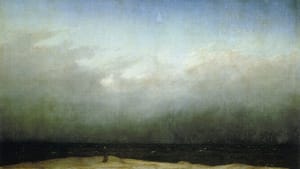Stay in the Loop
BSR publishes on a weekly schedule, with an email newsletter every Wednesday and Thursday morning. There’s no paywall, and subscribing is always free.
Piet Mondrian, lighthouses, and horizons

A few years ago, my friend suggested a particular meadow I might want to draw. This friend, who is not actually an artist but with whom I draw on a regular basis, often suggests things to draw.
No, I said, the meadow is picturesque but not interesting enough — visually dynamic enough — to create a composition. I said it would be more interesting to sit on the side of the highway and draw the overpass of one road over another road: they offer light, shadow, and diagonals. The meadow merely offers nostalgia, nothing visually compelling.
Having made this distinction between the picturesque and something upon which to create a dynamic composition, I contradicted myself and suggested a road trip to draw lighthouses in Maryland and Virginia.The lighthouse seems to be the most picturesque image ever reproduced in photographs, paintings, and prints, running the gamut from the kitsch of Thomas Kinkade to Piet Mondrian’s early paintings of the lighthouse at Westkapelle. On this road trip, which developed into a kind of scavenger hunt of lighthouses, I was struck by the interesting names given to lighthouses, particularly the dislocating name of a lighthouse called Point No Point. What is a point without a point?
On this road trip, which developed into a kind of scavenger hunt of lighthouses, I was struck by the interesting names given to lighthouses, particularly the dislocating name of a lighthouse called Point No Point. What is a point without a point?
Identifying the point
Ambiguity surrounding lighthouses became more evident when I brought my drawings into the studio. I was working on a particular lighthouse painting and inadvertently placed it next to another working landscape. This other landscape was a nebulous scene of sky and water with just a suggestion of the horizon. When placed side by side, the paintings emphasized the lighthouse as form against the sea as non-form; the intersection of the tangible with the intangible.
On a clear day, the sea-sky nothingness is visually organized by the horizon; the irony is that this visually organizing horizon is an illusion.
Regardless of its illusion, the horizon works in conjunction with the vertical to create a world in which we understand. Our world is made up of horizons and verticals — with an occasional dramatic diagonal — and it is not surprising that Mondrian in his later works reduced his marks to lines signifying these two directions. While most creation myths of any culture begin with this horizontal line dividing earth and sky or heaven and hell, it is not until the vertical line is inserted that the world becomes inhabited. All landscape artists know this. Caspar David Friedrich’s Monk by the Sea is a strong example of this inhabitation.
Collapsing planes
I see many lighthouse drawings from my prison students. They are lumpen lighthouses; lighthouses for the spatially dispossessed. The sky is drawn on the same picture plane as the sea, the sea on the same plane as the lighthouse, the lighthouse on the same plane as the foreground, and the foreground on the same plane as the background.
There is no space in these drawings — as if the prisoners know what we do not, that measurable space does not exist. For what is measurable space in prison where 100 miles from home is equal to a single mile from home; a single mile is equal to never and nowhere from home; time and space collapse into each other? What purpose can distance and time have in prison?
I mention their spatial dilemma to my prison students. I tell them; maybe you are living in a Gothic painting.
 I tell them that in a Gothic painting, a mountain could appear the same size as a man, or the Madonna may be 18 feet high sitting on a two-inch donkey. Space is collapsed to the foreground.
I tell them that in a Gothic painting, a mountain could appear the same size as a man, or the Madonna may be 18 feet high sitting on a two-inch donkey. Space is collapsed to the foreground.
I tell them that in Mondrian’s later paintings, space also appears collapsed. Vertical and horizontal lines are painted on a white background. In neither the Gothic paintings nor in later Mondrian abstractions is there any reference to perspectival space.
The prisoners are not living in a Gothic or Mondrian painting; they are living in the antithesis of that. In a Gothic painting, space is not destroyed but is superseded with spirituality; meaning has no need for spatiality, and therefore space becomes ambiguous.
 Mondrian understands it is the ambiguity of space that gives meaningful dimension to experience. In Mondrian’s later paintings, ambiguous space is disclosed — space that cannot be identified by the grid of his lines or the whiteness upon which he paints this grid. This is the space between the lines and the whiteness; it is space not seen, but experienced; it is ubiquitous and mysterious space where the intangible intersects the tangible.
Mondrian understands it is the ambiguity of space that gives meaningful dimension to experience. In Mondrian’s later paintings, ambiguous space is disclosed — space that cannot be identified by the grid of his lines or the whiteness upon which he paints this grid. This is the space between the lines and the whiteness; it is space not seen, but experienced; it is ubiquitous and mysterious space where the intangible intersects the tangible.
Space and time
There is no mysterious space in prison, and its collapse of space is not replaced by meaning; all meaning is destroyed. Distance and time do not become irrelevant; they are totally nuked.
Where is the horizon in prison? My students do not know and neither do I. When a student hopefully interjects that he is living closer to home than ever before in his incarceration, I ask if this has made a difference in his life. He answers sadly: No, it doesn’t matter; no one ever visits me.
We do not live in measured space, and we cannot live in the annihilation of space; we can only live in ambiguous space. Mondrian knew this as well as the Gothic painters. If I had to run the mile to my neighbor for help, I could do it; that same mile to a person in a wheelchair could mean a death sentence. Without ambiguous space and the horizon, the fluidity of meaning is destroyed and life becomes insignificant.
The lighthouse called Point No Point compels me. Unlike the other lighthouses that mark a specific point in space, this lighthouse makes no assumption. It is a lighthouse built upon water on which no permanent marking can be recorded, liquid and always changing. Like Mondrian’s space between the grid and the whiteness, Point No Point Lighthouse occupies ambiguous space facing an intangible horizon where meaning is full, always changing, and never reduced to absolutes; the lighthouse offers no clichés; it offers no false clarity.
I imagine a space with an intangible horizon, and on this horizon I imagine prisoners are walking, leading an eighteen-foot Madonna and her two-inch donkey.
Other images, top to bottom: Piet Mondrian, Lighthouse at Westkapelle, 1909; Simone Martini, Madonna of Mercy, 1308, Pinacoteca Nazionale, Siena, Italy; Piet Mondrian, Composition, 1936, Philadelphia Museum of Art.
Sign up for our newsletter
All of the week's new articles, all in one place. Sign up for the free weekly BSR newsletters, and don't miss a conversation.
 Treacy Ziegler
Treacy Ziegler